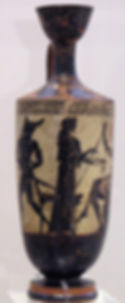Kykeon: The Drink of Champions
- Hellenic Museum
- Sep 6, 2021
- 3 min read
Updated: Oct 8, 2021
“In this the woman, as fair as a goddess, mixed them a mess with Pramnian wine; she grated goat’s milk cheese into it with a bronze grater, threw in a handful of white barley-meal, and having thus prepared the mess she bade them drink it.”
Homer, Iliad XI 638-41
“[Circe] brought them in and made them sit on chairs and seats, and made for them a potion of cheese and barley meal and yellow honey with Pramnian wine; but in the food she mixed baneful drugs, that they might utterly forget their native land.”
Homer, Odyssey X 305-310
“Then Metaneira offered [Demeter] a cup, having filled it with honey-sweet wine.
But she refused, saying that it was divinely ordained that she not
drink red wine. Then [Demeter] ordered [Metaneira] to mix some barley and water with delicate pennyroyal, and to give [Demeter] that potion to drink.
So [Metaneira] made the kukeôn and offered it to the goddess, just as she had ordered.”
Homer, Hymn to Demeter, 206-210.
The ancient drink known as kykeon was a popular beverage in ancient Greece that usually consisted of water and barley, along with honey, wine, cheese and herbs, depending on the recipe. It was drunk by both heroes in the epics, and ordinary folk, but is predominantly famous for being used in the Rites of Demeter in Eleusis in the ritual known as the Eleusinian Mysteries.
To recreate it, we will be looking at a recipe for kykeon from The Classical Cookbook (2012) by Andrew Dalby and Sally Grainger*. As no recipes (that is, specific measurements and instructions) survive from ancient Greece, the method followed here, and adapted to modern tastes, comes from Cato’s farming handbook (De Agricultura, 85) which outlines a porridge very near to kykeon.
What you’ll need
¾ cup / 120g semolina
375g ricotta cheese
2 tbs honey
1 small beaten egg
Saucepan
Wooden spoon
Cups to serve

Step 1
Place the semolina in your saucepan (off the heat) and add just enough water to cover it. Let it soak for at least 10 minutes and once it’s soft, drain the excess water.
Super easy so far - and when a recipe is a bit too straightforward, disaster is inevitable

Step 2
Place the saucepan with the semolina on your stovetop and add the ricotta cheese, honey and beaten egg. Bring it slowly to boiling point but do not let it boil.
At this point, the mixture did not look appetizing but hope remained!

Step 3
Stir slowly and allow it to simmer for a few minutes.
Reader, this is where trouble ensued. The mixture was left to simmer for a minute or two too long and the end result was definitely more like porridge, less pourable. Was it ruined? No, but it not quite what we were after.
Final thoughts
The final outcome was essentially a porridge but without the desired consistency (i.e. drinkable). Setting aside its consistency though, what about the taste? Well, the concoction did smell distinctly of cheese and this remained true for the taste as well. More honey was added in the vain hope of sweetening it, but to no avail. On a positive note, however, a family member who was game to try it did enjoy it. The subjectivity of taste, eh?
Now, the recipe used is not from ancient Greece per se and is more kykeon-adjacent but it does follow a similar vein. Would it be possible to substitute the water for wine and/or semolina for barley flour? Yes. There are a few recreations available online, including this one which follows more in line the Homer’s (albeit brief) directions:
Which recipe would you prefer?
* Dalby, A., & Grainger, S., 2012, The Classical Cookbook, J. Paul Getty Museum, USA: Los Angeles.







